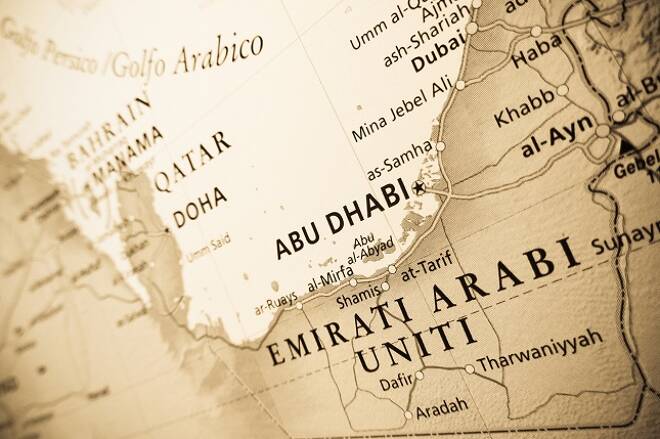Advertisement
Advertisement
Qatar in Boiling Water
By:
Mideast unstoppable tensions' shadows had always direct influence on the financial markets since the 70s of the previous century. However, the surface
Mideast unstoppable tensions’ shadows had always direct influence on the financial markets since the 70s of the previous century. However, the surface aspects of every single dilemma are usually hiding a devil fact in the details.
On June 4th a sudden rift between Arab countries took place amid major political and economic events. Saudi Arabia, Bahrain, Emirates and Egypt decided to cut ties completely with Qatar; in addition, Jordan had decided to downgrade the diplomatic ties recently. This rift came after allegations from the six Arab countries accusing Qatar by financing terrorism. The truth behind the incident could be far away from its aspect, which may lead to more financial turmoil.
Shadows of the Past Complicates Today’s Situation
Saudi Arabia and its rival Qatar are competing on taking on the leadership role of the Arab countries with different political perspectives. Qatar’s political line is clear and obvious in supporting the Arab spring revolutions and Muslims Brotherhood. On the other hand Saudi role seems to be ambiguous. During the fiftieth and sixtieth of the bygone century, Saudi Arabia was supporting Muslims Brotherhood against the socialist regimes in the Mideast, today it is against them. Today, Saudi Arabia oppose the Muslims Brotherhood; they are supporting Islamist groups in Syria and other places. In 2014 a similar conflict raised between the same sides around the political tensions in Egypt and the Arab spring direction, but it was settled down at the time.
In May 23rd the Qatari official news web site announced the outlines that included praising Iran, the necessity of withdrawing the Qatari ambassadors from gulf countries, also hoping that peace can find its way between Arabs and Israel, and also telling that Trump won’t last in the power for so long. From its side Qatar denied the incident and said that these announcements were made by the action of hackers penetrated the official web site and the official twitter account. Between May 23rd and June 4th no serious reaction was taken against Qatar.
The Trump Factor
The question is why the Arab countries waited from May 23rd to react finally on June 4th if there is any relation? Between those two dates two major events happened that prove that May 23rd web site announcements have no correlation to what happened in June 4th. In OPEC meeting on May 25th the GCC countries were all represented. Also on the Islamic countries summit in Saudi Arabia which Trump attended, Qatar’s ruler was in Riyadh alongside with all other leaders.
You might think that during that visit Donald Trump might play a direct role in that, but that is not a certain fact! One day before the Arab countries cut their ties with Qatar, a US Federal contractor leaked the NSA report proofing that Russia has intervened the US election. That leek came couple of days just before the former FBI director James Comey testimony on next Thursday. Now you can connect the dots.
From his side, Trump did not miss the chance to tweet on his account “So good to see the Saudi Arabia visit with the King and 50 countries already paying off. They said they would take a hard line on funding extremism, and all reference was pointing to Qatar. Perhaps this will be the beginning of the end to the horror of terrorism!”.
The Reflex of This Incident on the Markets
It is well known that any conflict arises in the gulf area leads to direct soaring in oil prices, especially when it comes to Qatar, the biggest exporter of the liquefied Natural Gas (LNG) worldwide. In this case, it didn’t happen for four main reasons. Firstly, the incidents’ result come to the mind of the other investors too. Secondly, the EIA announced on its monthly report of June that it expects increasing in the US oil production in 2018 from 8.9 mb/d to 9.3 mb/d; in addition, it is expected an increase of the LNG production from 73.3 to 74.3 bcf/d by 2018 without mentioning any concerns about Qatar which is producing third of the market needs. Third reason is the embargo made on Qatar by its neighbor does not include oil tankers owned by foreigners.
Fourth reason I mentioned previous week on my article “Yuan’s Arising Swing in the Markets”, which is the rising role of Yuan on oil that caused recently a decoupling between oil price and the dollar. Oil seemed to be much attracted to the USD/CNY pair.
The chart is showing how much the WTI is influenced by the pair positively since the US elections, which decoupled the negative correlation between the dollar and oil to from that relation with the Yuan. This pair is very influential on oil prices, because China is the second importer for oil.
On the Qatari side, the long term stable Riyal, which pegged by the USD, tumbled suddenly after the dilemma rose on the beginning of the month. The USD/QAR raised from 3.6414 to 3.6454, this movement considered dramatic and historical for this pair. This level has not been tested since 2007. Also the FTSE NASDAQ Qatar saw 600 pips drop in two days. On the other hand the other Arab countries’ stocks saw picking in prices.
About the Author
Mohamed Fathallacontributor
Latest news and analysis
Advertisement
